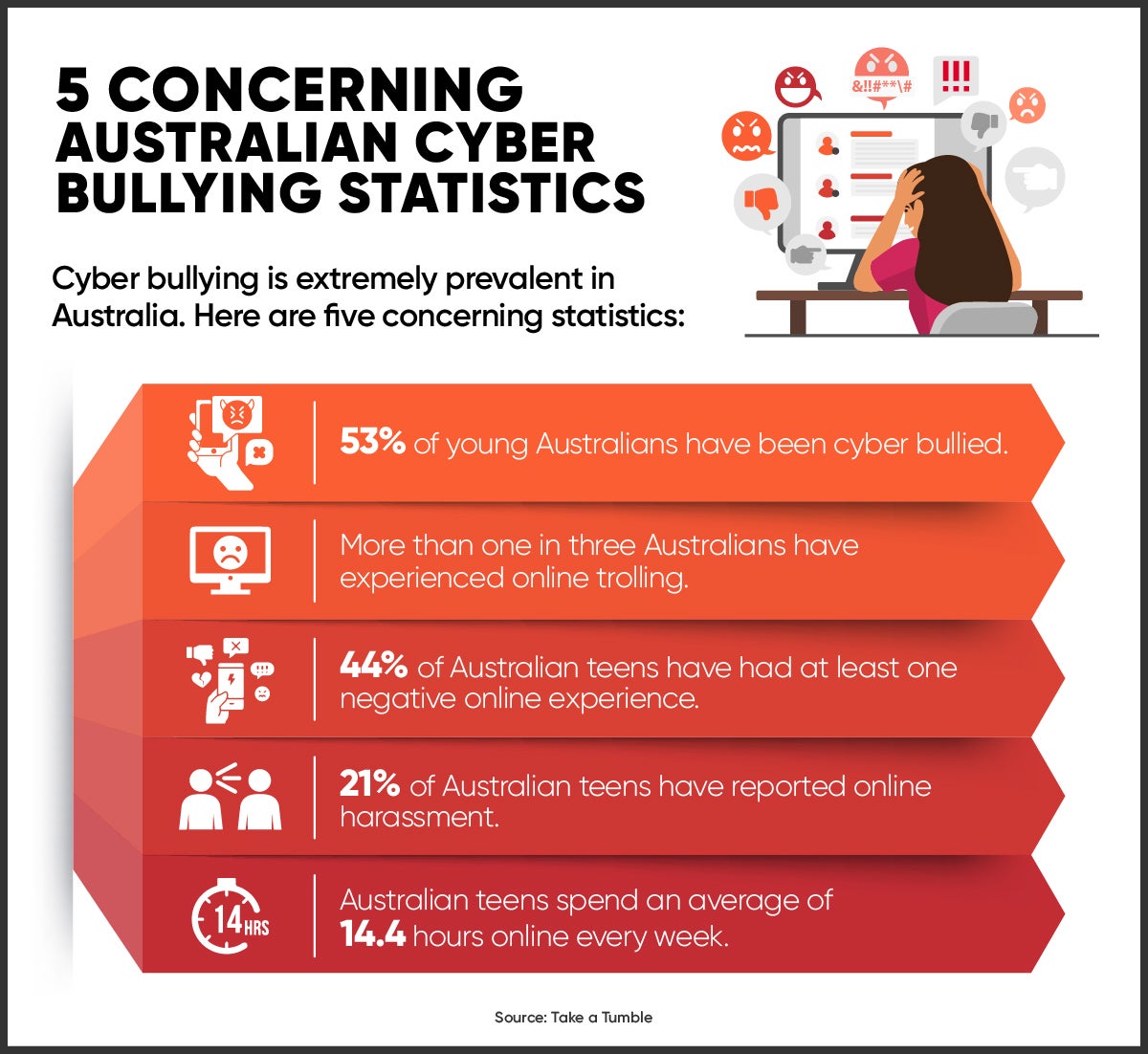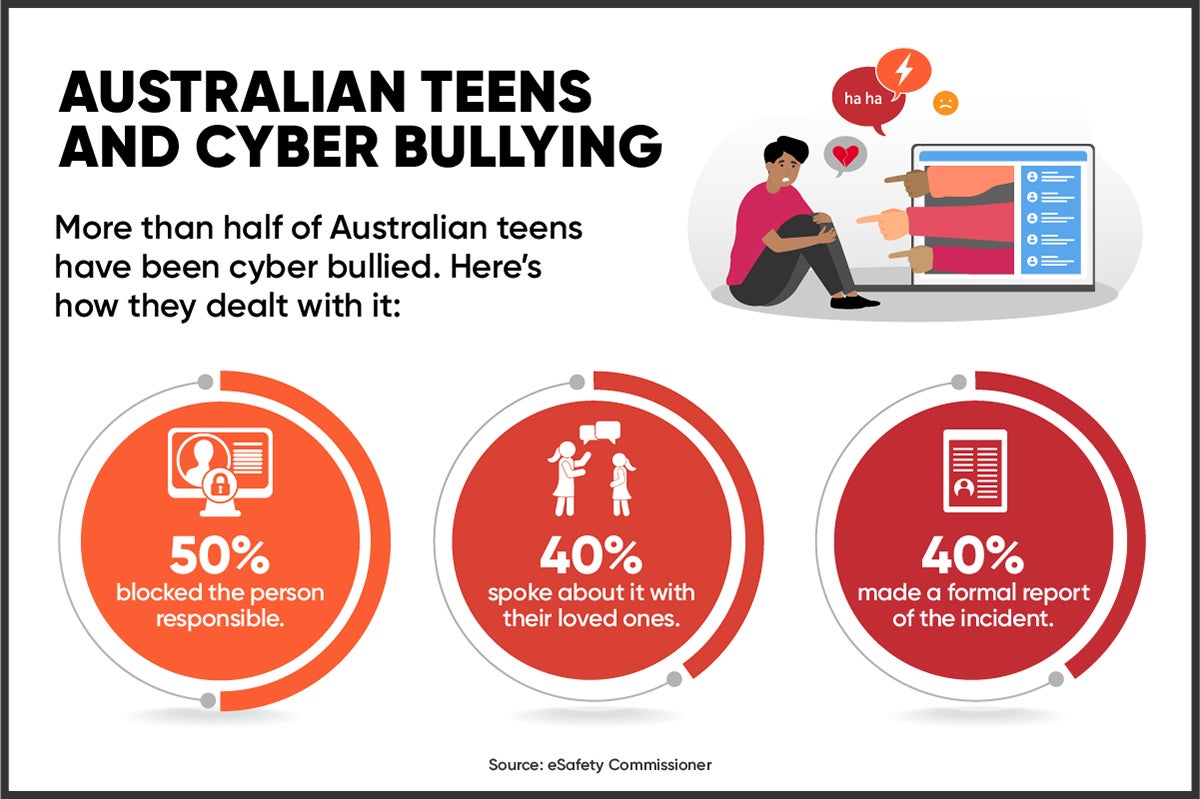
Cyberbullying in Australia: Statistics & Resources
Please note, this article includes content which may be distressing for some readers. Links for mental health support and resources can be found at the bottom of this page.
In decades past, bullying was mainly associated with schools and playgrounds — a problem that ended when children returned to the safety of their homes. While in-person bullying is still an issue in many schools, cyberbullying has taken over as the major concern for the health and wellbeing of school-age children.
According to a 2019 Headspace survey, 53% of young Australians experienced cyberbullying. Despite the widespread nature of the problem, some children and teens do not report cyberbullying, which can allow it to fester until it goes away — or becomes unbearable.
Cyberbullying in Australia is a major issue for children and teens, and those entrusted with taking care of children must understand both the problem and how it can be solved. Cyberbullying laws are still playing catch-up, despite the issue affecting half of Australia’s youth.
It’s clear that the need for professionals who can help children and adolescents through these challenges is greater than ever. If you want to support children and adolescents, ECU’s online Master of Counselling will give you the tools you need to make a difference.
What is cyberbullying?
According to the Australian Government’s eSafety Commissioner, cyberbullying occurs when a person uses social media or another internet-based method of communication to make a child, teen or adult feel sad or upset. While this issue commonly occurs on social media, it can also occur through texts, online gaming platforms, livestreams and emails.
Cyberbullying is intentional behaviour that causes physical, emotional or social harm. The behaviour must happen repeatedly to be considered cyberbullying. While the Commissioner focuses on cyberbullying’s effects on young people, adults can be affected by cyberbullying as well.
Cyberbullying in Australia is a complex issue that can have a lasting impact on victims. Unlike other types of bullying, cyberbullying is likely to go unnoticed by adults. Children who are embarrassed about being bullied or worried about being reprimanded for their online behaviour may be hesitant to tell a trusted adult when they are being cyberbullied.
Roles in cyberbullying
Children and teens may play several different roles in cyberbullying, including:
- Victim: The target of an attack.
- Cyber bully: The person who is bullying a victim online. This may be a single person or a group of people. Sometimes, fake online profiles mean that victims do not know who is cyberbullying them.
- Bystander: Someone who knows that cyberbullying is happening but does not take action to stop the behaviour, such as by telling a trusted adult or reporting the behaviour to an authority.
- Upstander: Someone who stands up to cyberbullying by confronting the perpetrator, reporting the behaviour or telling a trusted adult that someone is being cyberbullied.
Sometimes, children play several roles — for example, they may be a victim of cyberbullying while also cyberbullying someone else. One reason it can be hard to get children to open up about cyberbullying is that their roles are often complicated, and children may be worried about incriminating themselves, incriminating their friends or sharing that they knew about a cyberbullying issue for some time and chose to stay silent.
Types of bullying
To understand the effects of cyberbullying in Australia and globally, it’s essential to understand the different types of bullying, which include:
- Physical: Physical bullying is the most obvious type of bullying. When a bully hits, punches, slaps, shoves or otherwise physically assaults their victim, adults are more likely to notice, either by witnessing the attack or recognising physical evidence such as bruising.
- Verbal: Verbal bullying, such as name calling and put-downs, can be extremely hurtful, and can occur face to face or through other means of communication. This type of bullying can be harder for adults to notice, as it may happen quietly and does not leave physical evidence.
- Social: Social bullying can be very hard to notice, especially when the victim does not feel comfortable speaking up. Social bullying can include pushing the victim out of a social group, purposefully making the victim feel unwanted and refusing to acknowledge them in social situations. With social bullying, the perpetrator often works to get others on their side, further ostracising the victim from their social circle.
- Cyber: Cyberbullying falls into both the verbal bullying and social bullying categories. Cyberbullying occurs when a perpetrator sends hurtful or threatening messages to their victim online. Some platforms (such as Snapchat) make it especially difficult for adults to notice cyberbullying, as messages disappear after they’re seen.
- Bullying-like behaviour: Defining bullying-like behaviour can be difficult, but it’s clear when it’s happening. Bullying-like behaviour can involve making facial expressions that make someone else feel bad, laughing when someone gives an answer in class, making quiet comments that are easy to deflect or whispering to someone else in a way that makes the victim feel self-conscious.
- Sexual: Sexual bullying can appear as written, verbal, physical or social harassment where a connection is made to an individual or group with sexual intent. This type of behaviour can happen anywhere, at any time and is often degrading, humiliating and intimidating.
- Racial: Behaviour where an individual or group of individuals is mocked, shamed or intimidated because of their appearance, beliefs, or accent can be referred to as racial bullying.
- Homophobic: Homophobic bullying refers to anti-social behaviour resulting from one’s prejudice and dislike for those who identify or may be perceived as gay, lesbian, bisexual or transgender. Like the types of bullying mentioned above, it can take many forms and may present itself verbally, physically, written or online.
Cyberbullying facts and statistics in Australia
Cyberbullying statistics in Australia demonstrate how many young people experience negative online experiences. Consider these cyberbullying facts about how young people in Australia are affected:
- Percentage of young Australians who have been cyberbullied: 53 per cent
- Number of Australians who have experienced online trolling: more than one in three
- Percentage of Australian teens who have had at least one negative online experience: 44 per cent
- Percentage of Australian teens who have reported online harassment: 21 per cent
- Average number of hours Australian teens spend online every week: 14.4 hours
- Percentage of Australian teens who have sent a picture of themselves to a stranger online: 11 per cent
- Percentage of cyberbullying cases in Australia that were racially motivated: 17.9 per cent
- Percentage of Australian women who have been harassed online: 30 per cent
- Likelihood of LGBTQ+ children being bullied online compared to other children: three times more likely
- Students with a physical or mental health disability experience cyberbullying more than students without a disability. (10% of school students have some kind of disability).

Additional resource on cyberbullying statistics in Australia
- “Prevalence of Traditional Bullying and Cyberbullying Among Children and Adolescents in Australia: A Systematic Review and Meta-Analysis”: Learn more about the latest research into how cyberbullying and traditional bullying compare.
What are the cyberbullying laws in Australia?
Educators and parents aren’t the only ones to notice the effects of cyberbullying in Australia. Thankfully, bullying laws are changing, and cyberbullying laws in Australia work to protect people from cyberbullies.
Illegal acts that can apply to cyberbullying include:
- Using a phone or the internet menacingly: In Australia, it’s illegal to use technology to purposefully make someone else feel afraid. Many cyberbullies use social media and text messaging to intimidate their victims, which is unlawful.
- Stalking: Some cyberbullying victims understandably feel afraid to check their phones or computers due to the constant onslaught of messages they receive from their cyber bully. Both in-person and online stalking are illegal.
- Making threats: Whether a bully acts on a threat can be irrelevant — even threats that never come to fruition can make a victim afraid to go about their day-to-day life. It’s illegal to make threats to someone online, and this behaviour can be reported as a cyberbullying crime.
- Encouraging suicide: Messages such as “you should just kill yourself” can be common in cyberbullying. These messages can be devastating. These types of messages are illegal, and cyberbullies who send them can be prosecuted.
- Posting nude or offensive images (image-based abuse): Many victims of cyberbullying do not want to report their perpetrator for fear of getting in trouble for their own online activities, such as sending nude or otherwise private photos. It’s illegal to post someone else’s nude photos online without their permission. Sadly, blaming victims can lead to people living with the fear that their nude images may be posted online and being too afraid to speak out and get the help they need.
While these are some of the most common laws that can apply to cyberbullying in Australia, other malicious acts can also be considered crimes. State-based laws vary by state, and some prohibit logging into someone else’s account, using a mobile device or other internet-connected devices to commit a crime or publishing false information about a person.
Civil laws may also protect cyberbullying victims. Depending on the circumstance, a cyberbully may be charged with offending someone based on a personal characteristic or publicly encouraging hatred.
Support for cyberbullying victims
More and more, children and teens are realising that cyberbullying is both common and unacceptable, and they are taking the necessary steps to put it to a stop.
According to the Australian Institute of Health and Welfare, more than 80 per cent of Australian teens took action after they were cyberbullied, indicating that teens know adults take the issue seriously. This is a good sign — while cyberbullying is still rampant in Australia, teens are feeling more comfortable reaching out to get the help they need when they face the issue.
Online safety: Helping Australia’s teens
In Australia, teens are aware that cyberbullying is a problem, and many want to learn more about how to stay safe online, according to a study by the eSafety Commissioner:
- About 75 per cent of Australia’s teens want to know more about online safety.
- Forty-three per cent of Australia’s teens would prefer cyberbullying education in the form of school or safety courses that teach them more about how to identify it and what to do when they spot an issue.
- Forty per cent of Australian teens support the idea of an eSafety website that guides them on how to handle cyberbullying.
- 38 per cent of Australia’s teens would prefer that parents, guardians and educators were better informed about cyberbullying, making it easier for teens to report issues and get the help they need when it occurs.
Stopping cyberbullying: What adults need to know
When witnessing cyberbullying in action, it can be tough to know what to do to help the victim, especially if they don’t ask for help.

If a bystander witnesses cyberbullying, they can:
- Serve as an active bystander: Even when they aren’t the victim or the perpetrator, witnesses can speak up when they see that something isn’t right. They don’t necessarily need to confront the perpetrator (unless they feel safe and comfortable doing so). Talking to the victim about what they’re going through or talking to friends about why cyberbullying is not acceptable can help the person feel supported and understood, even if they aren’t ready to report the issue.
- Offer to report: Encouraging the victim to report the issue can be the first step toward solving the problem, but many victims do not feel comfortable reaching out to an adult. Witnesses can offer to report the issue to the victim after getting their permission. If the victim agrees, they can ask if the victim would prefer to involve a particular trusted adult.
- Provide support details: Offering cyberbullying victims mental health support can go a long way in helping them stay strong as they’re dealing with their perpetrator. Telling the victim about organisations that are available to support their well-being as they deal with cyberbullying can help them understand they aren’t alone and that there are steps that can help hold the perpetrator accountable. Keep reading for more information on how to get cyberbullying victims the help that they need.
Cyberbullying resources
From learning that others have dealt with the same thing to realising that what’s happening to them is a recognised crime, victims can gain the support they need to report their issues and stay strong.
Cyberbullying resources for Australians include:
- Office for the eSafety Commissioner: This site provides victims with information on what constitutes cyberbullying in Australia and offers support for both teen and adult victims. The eSafety Commissioner also offers victims the option to report offensive or abusive content so that it may be removed if deemed inappropriate.
- ReportCyber: Here, victims can report cyber crimes, including cyberbullying, on behalf of themselves or someone else. Reporting a cyber crime online can be a smart option for victims who do not feel comfortable speaking with someone face to face about their experience.
- Kids Helpline: This organisation works to provide kids with an understanding of what it means to be bullied and explains the possible consequences that bullying can have on a victim. The site explains to victims how they can get help, including how to report cyberbullying and how to reach out to a counsellor to get support.
- Bullying. No Way!: This site provides actionable information to help parents and educators support cyberbullying victims.
- National Centre Against Bullying: This site teaches parents how to notice signs that their child may be experiencing cyberbullying.
Moving forward
Cyberbullying in Australia is a serious problem, and thankfully, steps are being taken to help victims move forward with their lives. However, much work remains to be done to protect Australia’s youth from online abuse. Anyone who witnesses cyberbullying or something they think may qualify as cyberbullying should be sure to speak up — doing so could save a child’s life.
If you want to better support children and young people, ECU’s Master of Counselling will give you skills that you can apply to a range of settings. Whether you want to embark on a career as a counsellor or apply new skills to your role in education, healthcare or other community-based roles, our Master of Counselling will empower you to develop a practice that emphasises person-centred approaches.
If you or someone you know needs support, you can find help from the following services:
- Lifeline on 13 11 14
- MensLine Australia on 1300 789 978
- Suicide Call Back Service on 1300 659 467
- Beyond Blue on 1300 224 636
- 1800 Respect 1800737732
- Headspace on 1800 650 890
- ReachOut



